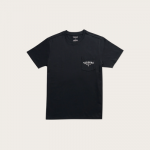The Evolution of Musical Genres: Annotated Timeline
Prehistoric and Ancient Foundations
-
Paleo (~40,000 BCE)
-
The earliest known human music, associated with ritual, social cohesion, and mimicking natural sounds. Inferred from archaeological finds like flutes and percussion, Paleo music laid the foundations of rhythm and tonal awareness that would influence Egyptian, African, and later Western musical traditions (Mithen, 2006).
-
-
African-American Roots (~6000 BCE)
-
Deep African rhythmic, melodic, and polyrhythmic structures, along with call-and-response patterns, formed the foundation of diasporic music traditions. These elements evolved into blues, jazz, gospel, and ultimately hip-hop (Kubik, 1999).
-
-
Egyptian (~7000 BCE)
-
Ancient Egyptian music developed with ritual and state functions, using lyres, flutes, and percussion. It drew on Paleo rhythmic and melodic concepts and influenced Mediterranean music traditions (Anderson, 2014).
-
-
Seikilos Epitaph (~200 BCE)
-
The oldest complete musical composition, blending Greek and Mediterranean tonalities. Foreshadowed structured melodic forms and influenced early Western chant traditions (D’Angour, 2013).
-
Sacred and Classical Traditions
-
Folk (~400 CE)
-
Rooted in communal, oral traditions, folk music preserved local histories and regional musical identities. It evolved from prehistoric and classical musical practices and would later influence country, blues, and rock (Nettl, 2005).
-
-
Gregorian Chant (~600 CE)
-
Codified monophonic liturgical melody in Christian Europe. Evolved from structured melodies like Seikilos Epitaph, shaping Western tonal thinking and leading to polyphony (Hiley, 2009).
-
-
Renaissance (1400–1600)
-
Expanded polyphony and secular experimentation. Evolved from Gregorian Chant, synthesizing sacred and secular styles, influencing Baroque forms (Bukofzer, 1947).
-
-
Baroque (1580–1750)
-
Characterized by elaborate counterpoint, ornamentation, and dynamic contrasts. Evolved from Renaissance polyphony, leading to Classical clarity and Romantic expressiveness (Bukofzer, 1947).
-
-
Classical (1750–1820)
-
Focused on balance, clarity, and structured forms. Evolved from Baroque complexity and Folk influences, paving the way for Romantic emotive expression (Plantinga, 1984).
-
-
Romantic (1820–1900)
-
Heightened emotional expression, expanded harmonic language, and programmatic music. Evolved from Classical structure, influencing late 19th-century popular and African-American music (Plantinga, 1984).
-
Caribbean and African-American Foundations
-
Kaiso (~1650)Trinidadian music blending African rhythms and European harmonic elements. Evolved from Paleo patterns, influencing Calypso, ska, and reggae (Liverpool, 1993).
-
-
Calypso (~1700)
-
Developed from Kaiso, emphasizing storytelling and social commentary, influencing Caribbean pop and early ska (Liverpool, 1993).
-
-
Mento (~1899)
-
Jamaican folk style combining Kaiso, Calypso, and European harmony. Influenced ska, reggae, and dancehall (Liverpool, 1993).
-
Early American Popular Forms
-
Rag-Time (~1820)
-
Syncopated piano music drawing on African-American roots, Folk, and Romantic harmonics. Scott Joplin popularized it as a precursor to jazz (Berlin, 1980).
-
-
Blues (~1880)
-
Evolved from African-American roots and spirituals. Emphasized emotional expression and 12-bar forms. Delta Blues later branched off (Wald, 2004).
-
-
Gospel (~1880)
-
Derived from African-American spirituals. Merged religious content with expressive vocal harmony, influencing soul, R&B, and rock (Wald, 2004).
-
-
Jazz (~1917)
-
Emerged from Blues, Rag-Time, African-American roots, and Romantic influence. Emphasized improvisation, swing, and complex harmony, influencing nearly all modern American genres (Gioia, 2011).
-
-
Delta Blues (~1926)Regional blues style. Evolved from Blues, influencing R&B, Rock ’n’ Roll, and later Rock subgenres (Wald, 2004).
-
-
Country (~1927)Emerged from Folk and Blues traditions. Narrative lyrics and string instrumentation shaped mainstream American music and influenced early rock (Palmer, 1992).
-
Mid-20th Century Innovations
-
R&B (~1940)
-
Fused Blues and Gospel into rhythmically driven forms, bridging to Rock ’n’ Roll (Palmer, 1992).
-
-
Latin-American (~1945)
-
Blended African-American roots, European harmonics, and indigenous rhythms. Influenced Jazz, Rock, and Disco (Manuel, 2006).
-
-
Rock ’n’ Roll (~1950)
-
Merged R&B, Gospel, and Country into youth-oriented, danceable styles. Influenced Pop, Psychedelic, and Hard Rock (Palmer, 1992).
-
-
Pop (~1951) and Pop Rock (~1951)
-
Commercialized rock, emphasizing mass appeal and hooks. Evolved from Rock ’n’ Roll and R&B (Holmes, 2012).
-
-
Electronic (~1950)
-
Combined Classical experimentation with African-American roots and global influences. Influenced Disco, Techno, and modern Pop (Holmes, 2012).
-
-
Soul (~1958)
-
Fused Gospel, R&B, Jazz, and Blues. Emphasized emotive vocals and rhythm, influencing Funk and later Pop Rock (Wald, 2004).
-
-
Ska (~1959)
-
Evolved from Caribbean fusion of R&B, Jazz, Calypso, and Mento. Precursor to Reggae and Rocksteady (Liverpool, 1993).
-
-
Motown (~1959)
-
R&B-Pop hybrid emphasizing harmonies and danceable rhythm. Evolved from R&B and Pop (Palmer, 1992).
-
1960s–1970s: Rock, Funk, and Reggae
-
Psychedelic Rock (~1960)
-
Fused Folk and Rock ’n’ Roll with studio experimentation. Led to Prog Rock and Art Rock (Palmer, 1992).
-
-
Hard Rock (~1965)
-
Amplified Rock ’n’ Roll. Influenced Heavy Metal and Blues Rock (Palmer, 1992).
-
-
Funk (~1965)
-
Merged Soul, Jazz, and R&B. Influenced Disco, Hip-Hop, and later Rap-Rock (Gioia, 2011).
-
-
Blues Rock (~1969)
-
Electrified Blues with Rock ’n’ Roll energy. Influenced Hard Rock, Heavy Metal, and Psychedelic Rock (Gioia, 2011).
-
-
Prog Rock (~1967) and Art Rock (~1975)
-
Expanded song structures, integrating Classical and Jazz. Influenced Post-Rock and later experimental rock (Palmer, 1992).
-
-
Heavy Metal (~1970)
-
Evolved from Hard Rock and Romantic intensity. Influenced Thrash, Alternative Metal, and Nu Metal (Palmer, 1992).
-
-
Reggae (~1968) and Reggae Rock (~1975)
-
Offshoots of Ska and Rocksteady. Influenced Caribbean-pop fusions and Rock hybrids (Liverpool, 1993).
-
-
Hip-Hop (~1973)
-
Developed from African-American Roots, Jazz, Funk, Soul, and Gospel. Influenced Rap-Rock, Rap-Metal, and Nu Metal (Chang, 2005).
-
-
Punk Rock (~1974) and Post-Punk (~1979)
-
Punk reacted against Rock excess. Post-Punk integrated Art Rock elements. Influenced Indie Rock and Industrial (Palmer, 1992).
-
-
Disco (~1975) and New Wave (~1977)
-
Disco evolved from Funk, Soul, R&B, Latin-American, and Electronic experimentation. “Disco” comes from French discothèque (Holmes, 2012). New Wave blended Punk, Disco, and Electronic, influencing Alternative Rock (Holmes, 2012).
-
-
Industrial (~1976) and Post-Industrial (~1985)Mechanical and electronic textures fused with rock aggression. Precursor to Nu Metal and Rap-Rock (Holmes, 2012).
-
1980s–1990s: Alternative, Metal & Shoegaze
-
Alternative Rock (~1980) and Shoegaze (~1985)Underground rock emphasizing texture, experimentation, and atmospheric sound. Influenced Grunge, Britpop, and Post-Rock (Palmer, 1992).
-
-
Thrash Metal (~1983) and Alternative Metal (~1989)Heavy, rhythmically complex metal fusions. Alternative Metal fused Alternative Rock with Heavy Metal, influencing Nu Metal (Palmer, 1992).
-
-
Britpop (~1990)UK-centered Alternative Rock with pop sensibilities. Influenced Post-Grunge and Indie Rock (Palmer, 1992).
-
Early 1990s: Grunge
-
Grunge (~1991)Fused Punk, Hard Rock, and Alternative Rock. Distorted guitars, sludgy rhythms, and introspective lyrics reshaped mainstream rock. Influenced Post-Grunge and Nu Metal (Weinstein, 2000; Palmer, 1992).
-
Post-Grunge to Rap-Metal & Hybrids (1995–2000s)
-
Post-Grunge (~1995)
-
Smoother, radio-friendly evolution of Grunge. Retained emotive vocals and guitar-driven sound. Influenced Pop Rock and Alternative Rock (Weinstein, 2000; Palmer, 1992).
-
-
Nu Metal (~1995)
-
Blended Alternative Metal, Hip-Hop, Funk, Industrial, and Grunge. Popularized by Deftones, Incubus, and Taproot (Palmer, 1992).
-
-
Math Rock (~1995)
-
Complex time signatures and experimental approaches. Influenced Post-Rock and Indie Rock (Palmer, 1992).
-
-
Post-Rock (~1994)
-
Deconstructed Rock, integrating Jazz, Electronic, and Art Rock. Influenced modern experimental rock (Holmes, 2012).
-
-
Rap-Rock (~1986) and Rap-Metal (~2000)
-
Fused Hip-Hop vocals with Rock/Metal instrumentation. Influenced Nu Metal and modern genre hybrids (Chang, 2005).
-
2000s–2010s: Contemporary Hybrids
-
Reggae Pop (~2010) and Trap Rock (~2015)
-
Modern fusions integrating Electronic production, Hip-Hop, and Reggae-Pop. Demonstrate ongoing dialogue of global and historical influences (Holmes, 2012).
Works Cited
-
Anderson, R. (2014). Music and Performance in Ancient Egypt. Routledge.
-
Berlin, E. (1980). Ragtime: A Musical and Cultural History. University of California Press.
-
Bukofzer, M. (1947). Music in the Baroque Era. W.W. Norton.
-
Chang, J. (2005). Can’t Stop Won’t Stop: A History of the Hip-Hop Generation. St. Martin’s Press.
-
D’Angour, A. (2013). “The Rediscovery of the Seikilos Epitaph.” Journal of Hellenic Studies.
-
Gioia, T. (2011). The History of Jazz. Oxford University Press.
-
Hiley, D. (2009). Gregorian Chant. Cambridge University Press.
-
Holmes, T. (2012). Electronic and Experimental Music: Technology, Music, and Culture. Routledge.
-
Kubik, G. (1999). Africa and the Blues. University Press of Mississippi.
-
Liverpool, H. (1993). Rituals of Power and Rebellion: The Carnival Tradition in Trinidad and Tobago. Research Associates.
-
Manuel, P. (2006). Caribbean Currents: Caribbean Music from Rumba to Reggae. Temple University Press.
-
Mithen, S. (2006). The Singing Neanderthals: The Origins of Music, Language, Mind, and Body. Harvard University Press.
-
Palmer, R. (1992). Deep Blues. Penguin.
-
Palmer, R. (1992). Rock & Roll: An Unruly History. Penguin.
-
Plantinga, L. (1984). Romantic Music: A History of Musical Style in Nineteenth-Century Europe. W.W. Norton.
-
Wald, E. (2004). Escaping the Delta: Robert Johnson and the Invention of the Blues. HarperCollins.
-
Weinstein, D. (2000). Heavy Metal: The Music and Its Culture. Da Capo Press.
-
Reynolds, S. (2005). Rip It Up and Start Again: Postpunk 1978–1984. Faber & Faber.
-
Nettl, B. (2005). The Study of Ethnomusicology: Thirty-one Issues and Concepts. University of Illinois Press.
© 2025 Good 2 Go Rock 'N' Roll








